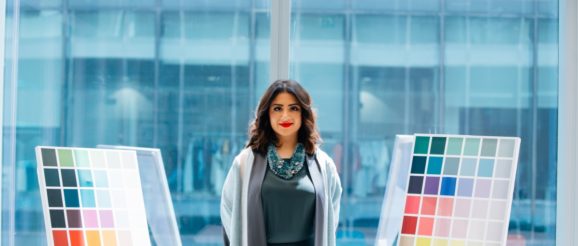Colour Psychology: The Effects of Colour on Human Behaviour with Fatima Al Shirawi – Imprint

Colour psychology is something I was introduced to a couple of years ago, and it refers to the study of colour in relation to human behaviour. Does it have that much influence though? From your choice of clothing, to the the colour of your walls, there is a lot to be said about those colour choices and how they make you feel. I met with Fatima Al Shirawi, an Emirati entrepreneur and founder of the The Gracious F Colour Consulting Company to discuss the concept of colour and its varying effects on the human psyche.
Fatima is a certified colour psychologist, offering bespoke experiences and customised solutions in colour psychology. The colour consultation experience is an interesting one, based on a colour matrix of four groups, to which the client’s personality is matched – each group with its own set of hues creating a unique profile for each person. From this point, one can then learn more about how to use colours in their day to day life – from behavioural traits, to moods and energies, seasonality to life events, creating an understanding of where everything fits within the colour spectrum. Considering the majority of us are currently spending most of our time at home, this could be a useful exercise in home decorating or daily dressing, to help balance out our moods in these uncertain times.
The significance of colour
Fatima talks about the importance of colour in our day to day routines, explaining how we interact with a constant flow of vibrations from the colours around us. “We are surrounded by so many colours and each of these colours has particular vibrations that we’re taking in during the day. The key thing is to know how to balance the vibrations that we receive.” So how do we create this sense of balance? “We teach the individual how to use the primary psychology colours to balance out their day and to portray themselves in a particular mood, or certain behaviour for them to be in a particular state of mind.”
The importance of colour in communication
From social situations to business meetings, it’s interesting to understand how colours can impact the way we communicate with others, and how we present ourselves in these situations, and it’s all about understanding the different qualities of those colours. Fatima says, “One particularly good thing about knowing your colour group is that you not only know the colours that change your mood or behaviour, you also understand certain personality characteristics associated with particular colour groups. This helps you to communicate – first of all wearing the colours that give you the confidence to be open to communicate, and second to help you to communicate with the other person, and with their mind set – understanding what attracts them, or even the colours to surround the other person with in this particular situation.”
Colours that help to inspire, uplift and make us feel at ease
Fatima talks about the different scenarios where colour can help put us at ease, or change our focus. “There are some days where you prefer to be on your own, and this is, I would say, the time for your healing. This goes into colour therapy which deals with your chakras, where you may have certain blockages and there are particular colours of each chakra that you can use to activate your energy and your mood.” The yellow hues are used to make you feel a bit more energetic, more inclined to go out and do things, whereas “your light greens or your greys give you that calmness, the solitude you require for a few hours. It’s all related to the vibrations that you receive from these colours and how your brain interprets the emotions you associate with these colours.”
The psychology behind our fashion choices and designing our personal spaces
“Interestingly, people always change the colours that they wear, or they surround themselves with when they’re going through different life transitions, so it’s kind of an interpretation of their state of mind. It’s usually when people go through a transition – that is when they want to change the colour.” What are some examples of this theory? Fatima says, “A lot of new mums are automatically drawn to the colour white, because it’s a new beginning in their life, and at the same time they have so much chaos around them, they’re craving clarity, whereas someone who is going through a career change will be drawn to blue for a sustained period because they’re focused on finding their passion.“ It’s interesting how we are instinctively drawn to particular colours based on our moods and life situations. Fatima explains that, “It’s not that they just randomly feel like changing the colour of their living room, or changing what they wear; it’s about the state of mind that they’re transitioning to in the different phases of their lives.”
To learn more about your personal colour profile, and how you respond to different colour scales, get in touch with Fatima Al Shirawi at The Gracious F.
